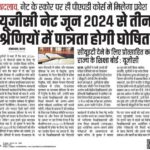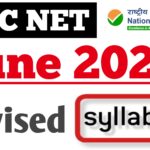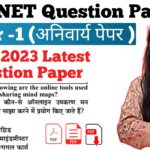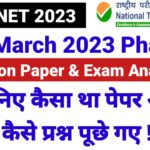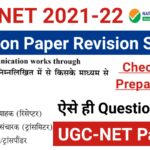Day 5 of UGC NET 2021 is being conducted on November 25 in two shifts for Various subjects. The analysis available on this page is prepared on the basis of feedback received from experts and students. UGC NET 25th November 2021 Question Paper Analysis Shift 1 & 2
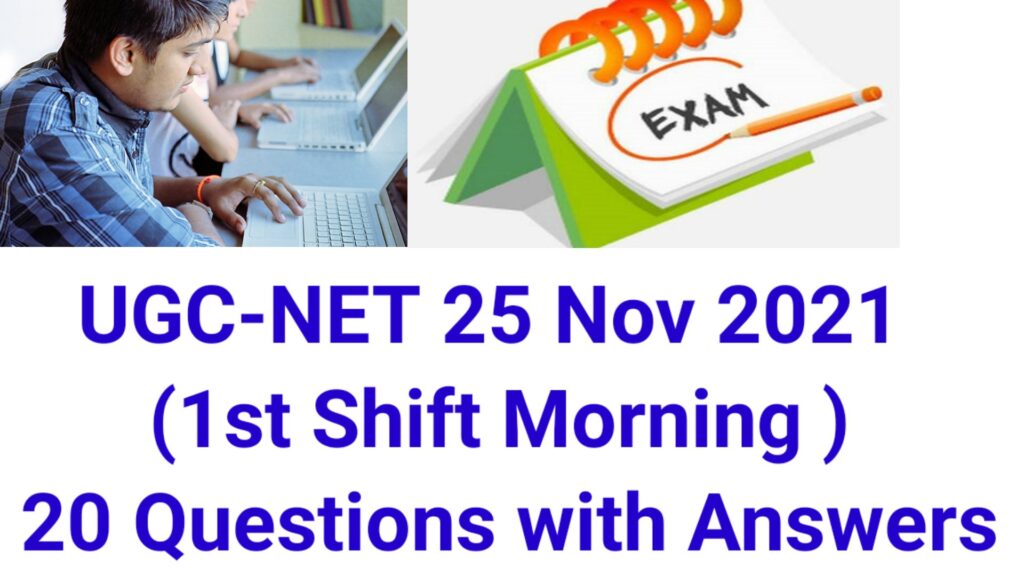
UGC NET 25th November 2021 Question Paper Analysis Paper-1
For UGC NET 2021 paper 1, there are a total of 50 questions consisting of a total of 100 marks. The complete exam analysis for UGC NET 2021 paper 1 has been updated below:
| Factor | Analysis |
| Exam Difficulty Level | Moderate |
| Difficulty Level of Teaching Aptitude | Moderate |
| Difficulty Level of Research Aptitude | Moderate |
| Difficulty Level of Comprehension | Easy |
| Difficulty Level of Communication | Easy |
| Difficulty Level of Mathematical Reasoning and Aptitude | Moderate |
| Difficulty Level of Logical Reasoning | Moderate |
| Difficulty Level of Data Interpretation | Easy |
| Difficulty Level of Information and Communication Technology | Moderate |
| Difficulty Level of People, Development and Environment | Moderate |
| Difficulty Level of Higher Education System | Moderate |
Question Asked in UGC NET 25th November 2021 Question Paper Analysis Shift -1 & 2
Q 1 number Series- 1 , 1.5,2.5,4 ?
Ans-6
Q2 As per NEP 2020 B.ed Course Completed in ?
Is BEd one year in new education policy?
In line with the New Education Policy (NEP), the government has notified a four-year integrated teacher education programme. Now, the BEd course will be integrated and will be of four-year duration. Students who pursue a four-year BEd degree will get BA and BEd or BSc and BEd or BCom and BEd degrees together.
Q2 NEP 2020 के अनुसार B.ed कोर्स पूरा हुआ?
क्या नई शिक्षा नीति में बीएड एक साल है?
नई शिक्षा नीति (एनईपी) के अनुरूप, सरकार ने चार वर्षीय एकीकृत शिक्षक शिक्षा कार्यक्रम को अधिसूचित किया है। अब, बीएड पाठ्यक्रम को एकीकृत किया जाएगा और यह चार साल की अवधि का होगा। चार साल की बीएड डिग्री हासिल करने वाले छात्रों को बीए और बीएड या बीएससी और बीएड या बीकॉम और बीएड की डिग्री एक साथ मिलेगी।
Q3 Which renewable energy is best for India?
Solar, wind and run-of-the-river hydroelectricity are environment-friendly cheaper power sources they are used as “”must-run” sources in India to cater for the base load, and the polluting and foreign-import dependent coal-fired power is increasingly being moved from the “must-run base load” power generation to the …

Q3 भारत के लिए कौन सी अक्षय ऊर्जा सबसे अच्छी है?
सौर, पवन और रन-ऑफ-द-रिवर जलविद्युत पर्यावरण के अनुकूल सस्ते बिजली स्रोत हैं, जिनका उपयोग भारत में बेस लोड, और प्रदूषणकारी और विदेशी-आयात पर निर्भर कोयले से चलने के लिए “”जरूरी” स्रोतों के रूप में किया जाता है। बिजली को “मस्ट-रन बेस लोड” बिजली उत्पादन से तेजी से स्थानांतरित किया जा रहा है
Q4 Matching
AICTE-Technical
NCTE
Q5 SDG Contribution Country wise in Order-
Which country has achieved the most SDGs?
Rankings
| Rank | Country | Score |
| 1 | Finland | 85.90 |
| 2 | Sweden | 85.61 |
| 3 | Denmark | 84.86 |
| 4 | Germany | 82.48 |
Q6 How many animals are on the IUCN Red List /?
138,300 species
Currently, there are more than 138,300 species on The IUCN Red List, with more than 38,500 species threatened with extinction, including 41% of amphibians, 37% of sharks and rays, 34% of conifers, 33% of reef building corals, 26% of mammals and 14% of birds.
Q6 IUCN रेड लिस्ट में कितने जानवर हैं /?
138,300 प्रजातियां
वर्तमान में, IUCN रेड लिस्ट में 138,300 से अधिक प्रजातियां हैं, जिनमें 38,500 से अधिक प्रजातियां विलुप्त होने के कगार पर हैं, जिनमें 41% उभयचर, 37% शार्क और किरणें, 34% कोनिफ़र, 33% रीफ़ बिल्डिंग कोरल, 26% शामिल हैं। स्तनधारियों और 14% पक्षियों की।
Q7 राष्ट्रीय उच्चतर शिक्षा अभियान (आरयूएसए)
एक केंद्र प्रायोजित योजना (सीएसएस) है, जिसे 2013 में शुरू किया गया था, जिसका उद्देश्य पात्र राज्य उच्च शिक्षण संस्थानों को रणनीतिक वित्त पोषण प्रदान करना है। केंद्रीय वित्त पोषण (सामान्य श्रेणी के राज्यों के लिए 60:40 के अनुपात में, विशेष श्रेणी के राज्यों के लिए 90:10 और केंद्र शासित प्रदेशों के लिए 100% के अनुपात में) मानदंड आधारित और परिणाम पर निर्भर होगा। फंडिंग केंद्रीय मंत्रालय से राज्य सरकारों/केंद्र शासित प्रदेशों के माध्यम से पहचान किए गए संस्थानों तक पहुंचने से पहले राज्य उच्च शिक्षा परिषदों में प्रवाहित होगी। राज्यों को वित्त पोषण राज्य उच्च शिक्षा योजनाओं के महत्वपूर्ण मूल्यांकन के आधार पर किया जाएगा, जो उच्च शिक्षा में समानता, पहुंच और उत्कृष्टता के मुद्दों को संबोधित करने के लिए प्रत्येक राज्य की रणनीति का वर्णन करेगा।
Also Read-
Ugc Net 24 Nov 2021 Exam Analysis
उद्देश्यों
रूसा के मुख्य उद्देश्य हैं;
निर्धारित मानदंडों और मानकों के अनुरूप सुनिश्चित करके राज्य संस्थानों की समग्र गुणवत्ता में सुधार करना और अनिवार्य गुणवत्ता आश्वासन ढांचे के रूप में मान्यता को अपनाना।
राज्य स्तर पर योजना और निगरानी के लिए एक सुगम संस्थागत संरचना बनाकर, राज्य के विश्वविद्यालयों में स्वायत्तता को बढ़ावा देने और संस्थानों में शासन में सुधार करके राज्य उच्च शिक्षा प्रणाली में परिवर्तनकारी सुधार।
संबद्धता, शैक्षणिक और परीक्षा प्रणाली में सुधार सुनिश्चित करना।
सभी उच्च शिक्षण संस्थानों में गुणवत्तापूर्ण शिक्षकों की पर्याप्त उपलब्धता सुनिश्चित करना और रोजगार के सभी स्तरों पर क्षमता निर्माण सुनिश्चित करना।
अनुसंधान और नवाचारों के लिए खुद को समर्पित करने के लिए उच्च शिक्षण संस्थानों में एक सक्षम माहौल बनाना।
नामांकन लक्ष्यों को प्राप्त करने के लिए मौजूदा संस्थानों में अतिरिक्त क्षमता बनाकर और नए संस्थानों की स्थापना करके संस्थागत आधार का विस्तार करें।
असेवित और कम सेवा वाले क्षेत्रों में संस्थानों की स्थापना करके उच्च शिक्षा तक पहुंच में क्षेत्रीय असंतुलन को ठीक करना।
अनुसूचित जाति/अनुसूचित जनजाति और सामाजिक और शैक्षिक रूप से पिछड़े वर्गों को उच्च शिक्षा के पर्याप्त अवसर प्रदान करके उच्च शिक्षा में समानता में सुधार करना; महिलाओं, अल्पसंख्यकों और नि:शक्तजनों के समावेश को बढ़ावा देना।RUSA
Rashtriya Uchchatar Shiksha Abhiyan (RUSA) is a Centrally Sponsored Scheme (CSS), launched in 2013 aims at providing strategic funding to eligible state higher educational institutions. The central funding (in the ratio of 60:40 for general category States, 90:10 for special category states and 100% for union territories) would be norm based and outcome dependent. The funding would flow from the central ministry through the state governments/union territories to the State Higher Education Councils before reaching the identified institutions. The funding to states would be made on the basis of critical appraisal of State Higher Education Plans, which would describe each state’s strategy to address issues of equity, access and excellence in higher education.
The salient objectives of RUSA are to;
Improve the overall quality of state institutions by ensuring conformity to prescribed norms and standards and adopt accreditation as a mandatory quality assurance framework.
Usher transformative reforms in the state higher education system by creating a facilitating institutional structure for planning and monitoring at the state level, promoting autonomy in State Universities and improving governance in institutions.
Ensure reforms in the affiliation, academic and examination systems.
Ensure adequate availability of quality faculty in all higher educational institutions and ensure capacity building at all levels of employment.
Create an enabling atmosphere in the higher educational institutions to devote themselves to research and innovations.
Expand the institutional base by creating additional capacity in existing institutions and establishing new institutions, in order to achieve enrolment targets.
Correct regional imbalances in access to higher education by setting up institutions in unserved & underserved areas.
Improve equity in higher education by providing adequate opportunities of higher education to SC/STs and socially and educationally backward classes; promote inclusion of women, minorities, and differently abled persons.
Q8 Basic Free Version of 200 m web meeting for online class-
Ans -40 MIN
Q 8 What is the best free online meeting platform?
The Best Free Video Conferencing Platforms
- Zoom.
- Google Hangouts.
- Dialpad Meetings.
- TrueConf Online.
- Skype.
- FreeConference.
- Lifesize Go.
- Slack Video Calls
Q9 How much arsenic is acceptable in water?
What is the regulatory standard for arsenic in drinking water? The current drinking water standard, or Maximum Contaminant Level (MCL), from the U.S. Environmental Protection Agency (EPA) is 0.010 mg/L or parts per million (ppm). This is equal to 10 ug/L (micrograms per liter) or 10 ppb.
Q9 पानी में कितना आर्सेनिक स्वीकार्य है?
पीने के पानी में आर्सेनिक के लिए नियामक मानक क्या है? यू.एस. पर्यावरण संरक्षण एजेंसी (ईपीए) से वर्तमान पेयजल मानक, या अधिकतम दूषित स्तर (एमसीएल), 0.010 मिलीग्राम/लीटर या प्रति मिलियन भाग (पीपीएम) है। यह 10 ug/L (माइक्रोग्राम प्रति लीटर) या 10 पीपीबी के बराबर है।
Q 10 Matching-
Audio
Video
Q11 Select Deemed University of india-
NEUPA
NCERT
JAMIA HUMDARD
JAMIA MILIA
IIT
Select Code –
Q12 GOVT Policy Matching
Q13 Communication Basic Parts
Q14 Clock wise Question
Q15 Square of opposition-
If E True
IF I True
Q16 Environment agreement

Q17 Growth compound interest
Q18 Fallacy /Indian logic from PYQ
Q19 Scientific Research
Q20 Which countries are mandated to reduce their HFC production by the year 2045 *?
China, which is the largest producer of HFCs in the world, will reduce HFC use by 80 per cent by 2045 over the 2020-22 baseline. India will reduce the use of HFCs by 85 per cent over the 2024-26 baseline.
Q20 किन देशों को वर्ष 2045* तक अपने HFC उत्पादन को कम करना अनिवार्य है?
चीन, जो दुनिया में एचएफसी का सबसे बड़ा उत्पादक है, 2020-22 बेसलाइन की तुलना में 2045 तक एचएफसी के उपयोग में 80 प्रतिशत की कमी करेगा। भारत 2024-26 बेसलाइन पर एचएफसी के उपयोग में 85 प्रतिशत की कमी करेगा।
Q21 CBCS
What does Cbcs mean?
Choice Based Credit System
Choice Based Credit System (CBCS) The Choice Based Credit System (CBCS) is an educational model that offers students to opt for courses & subjects of their choice – core, elective courses, open or global electives & skill-based courses.
सीबीसीएस का क्या मतलब है?
च्वाइस बेस्ड क्रेडिट सिस्टम
च्वाइस बेस्ड क्रेडिट सिस्टम (CBCS) च्वाइस बेस्ड क्रेडिट सिस्टम (CBCS) एक शैक्षिक मॉडल है जो छात्रों को अपनी पसंद के पाठ्यक्रम और विषयों – कोर, वैकल्पिक पाठ्यक्रम, खुले या वैश्विक ऐच्छिक और कौशल-आधारित पाठ्यक्रम चुनने की पेशकश करता है।

